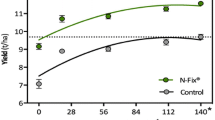Summary
Experiments to assess the ability of free-living cells of six strains of soybean rhizobia (Bradyrhizobium japonicum USDA 76, 94, 110, 122, 123, and 135) to denitrify nitrate in five soils showed that although some strains ofB. japonicum have the capacity to rapidly denitrify nitrate in soils under anaerobic conditions, it is unlikely that the numbers of soybean rhizobia commonly found under field conditions are sufficient to significantly influence either the extent or the products of denitrification in soil. It is our general conclusion that the advantages, if any, that the ability to denitrify conveys to rhizobia or to the rhizobia-legume symbiosis are not offset by increased losses of plant-available N when denitrifying strains of rhizobia are present as free-living cells in soil.
Similar content being viewed by others
References
Bezdicek DF (1972) Effect of soil factors on the distribution ofRhizobium japonicum serogroups. Soil Sci Soc Am J 36:305–307
Bhandari B, Nicholas DJD (1984) Denitrification of nitrate to nitrogen gas by washed cells ofRhizobium japonicum and by bacteroids fromGlycine max. Planta 161:81–85
Blackmer AM, Bremner JM (1977) Gas chromatographic analysis of soil atmospheres. Soil Sci Soc Am J 41:908–912
Bremner JM (1965) Inorganic forms of nitrogen. In: Black CA (ed) Methods of soil analysis, part 2. Am Soc Agron, Madison, Wisc, pp 1179–1237
Casella S, Leporini C, Nuti MP (1984) Nitrous oxide production by nitrogen-fixing, fast-growing rhizobia. Microb Ecol 10:107–114
Damirgi SM, Frederick LR, Anderson IC (1967) Serogroups ofRhizobium japonicum in soybean nodules as affected by soil types. Agron J 63:301–303
Daniel RM, Smith IM, Phillip JAD, Ratcliffe HD, Drozd JW, Bull AT (1980a) Anaerobic growth and denitrification byRhizobium japonicum and other rhizobia. J Gen Microbiol 120:517–521
Daniel RM, Steele KW, Limmer AW (1980b) Denitrification by rhizobia: A possible factor contributing to nitrogen losses from soils. NZ J Agric Sci 14:109–112
Daniel RM, Limmer AW, Steele KW, Smith IM (1982) Anaerobic growth, nitrate reduction and denitrification in 46Rhizobium strains. J Gen Microbiol 128:1811–1815
Erdman LW, Johnson HW, Clark F (1957) Varietal responses of soybeans to a bacteria-induced chlorosis. Agron J 49:267–271
Evans HJ (1954) Diphosphopyridine nucleotide-nitrate reductase from soybean nodules. Plant Physiol 29:298–301
Gamble TH, Betlach MR, Tiedje JM (1977) Numerically dominant denitrifying bacteria from world soils. Appl Environ Microbiol 33:926–939
Giannakis C, Nicholas DJD, Wallace W (1988) Utilization of nitrate by bacteroids ofBradyrhizobium japonicum in the soybean root nodule. Planta 174:51–58
Ham GE, Frederick LR, Anderson IC (1971) Serogroups ofRhizobium japonicum in soybean nodules sampled in Iowa. Agron J 63:69–72
Ishizawa S (1939) On the consumption of inorganic nitrogen by root nodule bacteria of leguminous plants. J Soil Sci Manure (Jpn) 13:135–143
Keyser HH, Weber DF (1979) USDA-BeltsvilleRhizobium culture collection catalogue. USDA PPHI Rep No 16
Murphy SG, Elkan GH (1965) Nitrogen metabolism of some strains ofRhizobium japonicum having different nodulating capabilities. Can J Microbiol 11:1039–1041
O'Hara GW, Daniel RM, Steele KW (1983) Effect of oxygen on the synthesis, activity and breakdown of theRhizobium denitrification system. J Gen Microbiol 129:2405–2412
Pagan JD, Scowcroft WR, Dudman WF, Gibson AH (1977) Nitrogen fixation in nitrate reductase-deficient mutants of cultured rhizobia. J Bacteriol 129:718–723
Payne WC (1981) The status of nitric oxide and nitrous oxide as intermediates in denitrification. In: Delwiche CC (ed) Denitrification, nitrification and atmospheric nitrous oxide. Wiley, New York
Rajapopalan T (1938) Studies on ground nut nodule organism: IV. Physiology of the organism: Intermediary metabolism. Indian J Agric Sci 8:379–402
Smith GB, Smith MS (1986) Symbiotic and free-living denitrification byBradyrhizobium japonicum. Soil Sci Soc Am J 50:349–354
Sprent JI, Giannakis C, Wallace W (1987) Transport of nitrate and calcium into legume root nodules. J Exp Bot 38:1121–1128
Stephens BD, Neyra CA (1983) Nitrate and nitrite reduction in relation to nitrogenase activity in soybean nodules andRhizobium japonicum bacteroids. Plant Physiol 71:731–735
Steel RGD, Torrie JH (1980) Principles and procedures of statistics, 2nd edn. McGraw-Hill, New York
Van Berkum P, Keyser HH (1985) Anaerobic growth and denitrification among different serogroups of soybean rhizobia. Appl Environ Microbiol 49:772–777
Weaver RW, Frederick LR (1974) Effect of inoculum rate on competitive nodulation of Glycine max L. Merrill: II. Field studies. Agron J 66:233–236
Weiss RF (1981) The temporal and spatial distribution of tropospheric nitrous oxide. J Geophys Res 86:7185–7195
Wilson JK (1947) The legume bacteria liberate gaseous nitrogen from nitrate. Soil Sci Soc Am J 21:215–216
Yoshinari T, Knowles R (1976) Acetylene inhibition of nitrous oxide reduction by denitrifying bacteria. Biochem Biophys Res Commun 69:705–710
Yung YL, Wang WC, Lacis AA (1976) Greenhouse effect due to atmospheric nitrous oxide. Geophys Res Lett 10:619–621
Zablotowicz RM, Focht DD (1979) Denitrification and anaerobic, nitrate-dependent acetylene reduction in cowpeaRhizobium. J Gen Microbiol 11:445–448
Zablotowicz RM, Eskew DL, Focht DD (1978) Denitrification inRhizobium. Can J Microbiol 24:215–216
Zantua MI, Bremner JM (1975) Comparison of methods of assaying urease activity in soils. Soil Biol Biochem 7:291–295
Author information
Authors and Affiliations
Rights and permissions
About this article
Cite this article
Breitenbeck, G.A., Bremner, J.M. Ability of free-living cells ofBradyrhizobium japonicum to denitrify in soils. Biol Fert Soils 7, 219–224 (1989). https://doi.org/10.1007/BF00709652
Received:
Issue Date:
DOI: https://doi.org/10.1007/BF00709652




